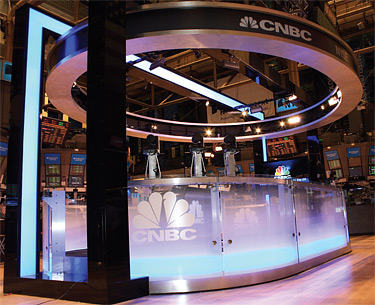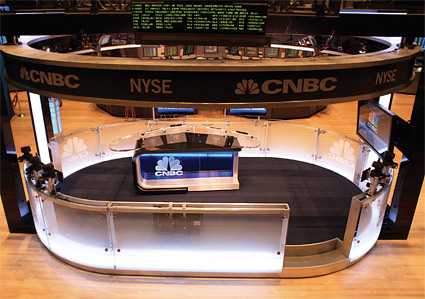CNBC Moves to the Stock Exchange Floor
NEW YORK-- Since its launch in the late 1980's CNBC has been at the forefront of capturing the sights and sounds of the action on the trading floor of the New York Stock Exchange. Over the years it has installed a small studio and platform around the peripheral and six years ago, the network brought wireless technology to its cameras covering the floor. But those were just hints of what were to come.
Later this month, CNBC will debut the first ever broadcast stage on the floor of the NYSE, in a spot previously occupied by "Post 9." The launch represents years of collaboration between CNBC and the NYSE to bring the atmosphere of the trading floor closer to viewers and traders alike.
"This the next step in our evolution," said Steve Fastook, vice president of technical operations for CNBC in Englewood, NJ. The new stage "puts us smack dab into the middle of the trading floor. You can't get closer to the action than that."
TRADING FLOOR RENOVATION
The project has been on Fastook's wish list for years as the network has steadily increased its trading floor presence, but became more of a reality when the NYSE moved ahead on a multi-year renovation of the trading floor.
"The NYSE has made a major effort to further modernize the floor," he said. "They're rebuilding the posts one at a time, taking out old wooden trading posts and putting in high-tech flat screens and other display technology, nice finishes and glass surfaces. But they're upgrading the floor while keeping in mind the traditional feel of the environment."

Capturing that ambience is a critical element of CNBC's reporting. In a traditional studio, silence is golden, however Fastook is enthusiastic about mixing CNBC's coverage with the floor noise. "We like and celebrate the fact that we are live on the floor. We live in the environment," he said.
Installing the set on the floor didn't come without some unique challenges. The set is front and center underneath the opening bell podium of the NYSE and had to occupy the exact footprint of the former DMM Post 9. The set had to have finished furniture and the design "needed to be in concert with the architectural design of the historical exchange with an eye to where it's going," Fastook said. "So our set designer worked closely with the NYSE staff and architects who are redesigning the floor of the exchange."
SELF-CONTAINED STAGE
The stage itself is a glass booth that occupies a 12x23-foot oval shaped area and no activity can venture beyond that footprint. There's enough room for four main contributors and one guest at the anchor desk. "The thing that makes this unique is that everything has to fit within the framework of the stage," Fastook said. "There can't be any tripods or jib arms, everything has to be self contained."
The stage is a glass booth that occupies a 12x23-foot oval shaped area and no activity can venture beyond that footprint. To fit that requirement, CNBC designed a rail system that allows five Panasonic PTZ robotic HD compact cameras to travel manually from position to position on a the rail that lines the booth. A 65-inch touchscreen monitor uses Point-HD's application to enable talent and financial analysts alike to annotate, draw trend lines, and control data driven graphics. "Everything we do is about bringing accurate information in real time," Fastook said. "We're able to take our Brainstorm analytical and data systems that reside in Englewood and play them out on the touchscreen. We can now do things on the floor that you had to traditionally go back to the studio for."
Advances in lighting have allowed CNBC to greatly reduce the heat and energy required to light the stage. PRG’s TruColor Foton LED-based focusable light fixtures are used as well as color Kinetic CB-12 multicolor soft lights for fill and soft lights and Rosco light panels are used on the anchor desk to create a low angle light. All lighting is compact and resides within the crown of the stage.
"Since we are in such close proximity to active traders," Fastook said. "We have to be careful not to distract them."
Although digital technology has revolutionized the way trading takes place on the floor of the NYSE, there's still a human element to the place. Flat screens have also radically changed the environment, with their thinner footprint and reduced energy consumption. "If you think of the amount of screens that are on that floor in those trading posts, when they became flat, the whole floor really lightened up," Fastook said. "The whir and whine of the CRTs was gone. That also made it more practical for us to do a broadcast."
CNBC will continue to use its other sets on the NYSE but the main focus will be on the floor stage. "It's a major location for us," Fastook said. "There aren't many places where you can have four anchors at a desk with a beautiful visual surrounding ,and it's made even better by the traders working alongside us. There's so much energy on the floor and we are excited to be a part of that."

Get the TV Tech Newsletter
The professional video industry's #1 source for news, trends and product and tech information. Sign up below.
Tom has covered the broadcast technology market for the past 25 years, including three years handling member communications for the National Association of Broadcasters followed by a year as editor of Video Technology News and DTV Business executive newsletters for Phillips Publishing. In 1999 he launched digitalbroadcasting.com for internet B2B portal Verticalnet. He is also a charter member of the CTA's Academy of Digital TV Pioneers. Since 2001, he has been editor-in-chief of TV Tech (www.tvtech.com), the leading source of news and information on broadcast and related media technology and is a frequent contributor and moderator to the brand’s Tech Leadership events.

